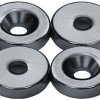Countersunk Magnets: From Purchase to Installation
You’ve probably seen them before: ring-shaped magnets that look like washers with wedges cut out of the middle. These are countersunk magnets. Also called countersink magnets, the design is intentional—the wedge and hole exist so the countersunk magnet can be anchored in place by a single screw. Their strange design makes them extremely useful in the right situations.
Two Variations of Countersunk/Countersink Magnets
Countersunk magnets come in two basic variations: all-magnet countersinks, which are solid pieces of magnet, and POT magnets, which house magnets inside steel casings. The all-magnet countersinks have two advantages:- They’re generally a little bit cheaper since you’re not paying for the housing.
- Their magnetic field is generally a little stronger because there’s no barrier (i.e., the housing) around them.
Uses for Countersunk Magnets
There are plenty of uses for countersunk magnets, especially if you’re creative. One of the most popular uses for countersinks is to keep doors open. To hold them open, people will screw a countersunk magnet into the floor at the edge of a door’s opening radius. When the door is swung open, it bumps against the countersunk, which it latches to either because the door itself is ferromagnetic or because a ferromagnetic material is attached to the door. Some people also use countersunk magnets to hold furniture in place on the floor or behind artwork to keep them attached to the wall. One of the most interesting uses of countersunk magnets we’ve seen is in workshops. Some people will cover a wall with outward-facing countersunk magnets to hold up objects they need to work on.Purchasing and Installing Countersunk Magnets
Before purchasing a countersunk magnet, there are two questions you should ask:- How much weight will the magnet need to hold? This will let you know how big of a countersunk you need.
- What size screw does it require? This will let you get the right equipment before you install.

